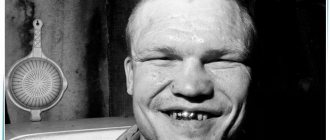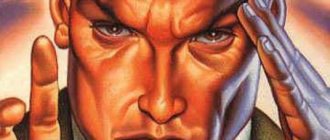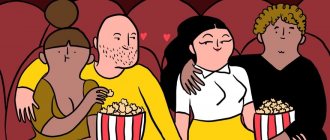How to learn to understand people based on their gestures and facial expressions? The psychology of facial expressions and gestures provides the answer to this question.
By studying and understanding this topic, you can ensure the absence of secrets and hidden meanings in conversations with others and learn to read people like an open book.
Do you agree that this ability is very useful?
Terms and concepts of the section on facial expressions and gestures
Gesticulation refrain, dictionary of symbols of psychoanatomy, ergonomics of gestures. What it is?
These phrases are difficult to understand for people who are encountering the topic of gestures and facial expressions for the first time. Simply put, these are the components of this branch of psychology, which allow us to understand facial expressions and gestures at a more detailed level than “his ears are burning, which means he’s lying.” Everything is much deeper and more serious than it might seem at first glance.
Gestural refrain —
it is a repeated gesture that always has the same meaning.
Here's an example. Crossed arms. If the right one lies on top of the left one, it means resentment. If it’s the other way around, it’s a defensive position.
The dictionary of psychoanatomy symbolism is a kind of decoding of sign language. Based on it, you can find out what certain gestures mean in the current situation. This section is considered purely on specific examples, since in different situations, the same gesture can be interpreted differently. Ergonomics of facial expressions and gestures is a section that describes the ability to adapt body language to solve specific problems. For example, influence the human psyche with the help of positive beliefs transmitted through gestures.
Learning gesture ergonomics is a great way to learn how to communicate more productively and effectively. It makes it possible to influence a person with gestures and facial expressions, which subconsciously evoke positive emotions in that person.
Fraudsters take advantage of this. For example, in order to win a person’s favor, a fraudster can touch his hand while telling an anecdote or some pleasant and funny story. Thus, the human brain begins to react positively to this gesture.
Then, when it comes to “turning off” the scam itself, the scammer accidentally touches the person’s hand again, awakening relaxation and positivity in his mind. This makes it easier to commit fraud, because a relaxed person will not begin to suspect something. His brain is deceived by psychology.
Gait
Gait is the style of movement of a person. It can say a lot about its owner. For example, a heavy gait indicates a person is overwhelmed with thoughts and is depressed. Light, “flying” - about high spirits and optimistic thinking. A person who is hunched over, with his head down and shuffling his feet often turns out to be unsure of himself, while someone who is straightened up and with his chin raised moderately high has good self-esteem and is very confident in himself.
A person with an active lifestyle and prone to taking initiative walks confidently, with long steps and moderate swinging of his arms. People who are unsure of themselves most often hide their hands in their pockets or behind their backs. A thinking person walks slowly, as if tracking his every step. People walk with their chins high and their legs straight, trying to demonstrate their superiority over others.
What does understanding facial expressions and gestures provide?
A short list of advantages:
- Active brain function.
You need to remember a bunch of gestures and movements that indicate a specific meaning. For example, if during a dialogue the interlocutor scratches the back of his head, this means that he is not confident in your words and is questioning them. There are many such examples that can be given, and most of them need to be kept in mind at all times.
- Ability to adapt and change the situation.
When you know more than you are told, you can more often find the right solutions in various situations, lead your interlocutor to something, or get answers where he does not even say them.
- Understanding a person's negative motivations.
Knowledge of this topic will give you the opportunity to protect yourself from lies, envy, unfriendliness, etc.
- Understanding the inner world of the interlocutor.
The correct interpretation of facial expressions and gestures not only makes it possible to look into the soul, finding out all the secrets of the interlocutor, but also to understand that he needs help, even though he is trying to hide it. In this case, you can try to find the right words and try to figure out the problem together.
- Developing the ability to notice the smallest details.
Without this ability, it is impossible to interpret the current picture from facial expressions and gestures. One unnoticed gesture can radically change the entire meaning of the signals given by the body. Therefore, if we want to correctly interpret another person's body language, we need to be more attentive and sensitive to little things.
- Self-development.
Self-development is an additional bonus when studying the psychology of facial expressions and gestures. A person learns to know both himself and those around him, learns something deep, and draws something useful for himself.
Physiognomy: shape of teeth in men and women
White, even teeth are considered in physiognomy to be a sign of good fate . They are also called “horse”, predicting health and good luck . Many friends are also predicted, because the owner of such teeth is sociable, friendly and always friendly .
Physiognomists consider white, even teeth ideal
If the front teeth are slightly larger than the others, this is a good omen for marriage. Financially, you should also expect prosperity.
IMPORTANT: It is advisable that the teeth taper downwards, not upwards.
Physiognomists consider large front teeth a good sign.
protruding forward are found in extraordinary natures, accustomed to achieving everything on their own. Often such people move far from home - and in their new place of residence they build a life from scratch.
Physiognomists describe people with protruding teeth as extraordinary natures
Diastema is a lucky sign. Such people live long and know how to earn good money. However, we are talking only about the distance between the front teeth - in other cases the gap should be small.
Diastema in physiognomy is a happy omen
As you can see, you can say quite a lot about a person without even having time to get to know him properly. If you remember the basic aspects of physiognomy, information from the interlocutor’s face will be read without much difficulty.
Where to start learning facial and sign language?
Let's consider all sources of knowledge on the psychology of facial expressions and gestures:
- Literature.
The first assistant in studying this topic. In addition to printed books, many specialists in this section of psychology publish magazines, open websites and maintain blogs on the Internet.
- Courses on studying the psychology of facial expressions and gestures.
A person who understands the topic will be able to personally show and explain how everything works and how to apply the acquired knowledge in life.
- Watch TV series or documentaries on this topic.
Oddly enough, a very large amount of information can be gleaned from there. Plus, everything is shown in practice, which makes it much easier to understand and learn the “lessons” in your head.
- Practice
.
Reading and watching is, of course, good, but it is necessary to apply the acquired knowledge in real conditions. This is the only way to absorb information and change something in your life.
Physiognomy at the present stage of development
Initially, physiognomists studied the features of the entire human body, but now facial features have become the focus of researchers.
In the field of view of researchers only congenital features of appearance:
- Shape, size, location of facial features
- Birthmarks
- Color of the skin
- The presence of various kinds of bulges and dents
- Wrinkle lines
- Scars
Convinced adherents of physiognomy believe that by learning to understand what information is embedded in facial features, you can learn a lot of new and useful information.
The meaning of gestures and facial expressions using specific examples
Theoretical knowledge must be examined in specific, simulated situations. This is the only way to correctly understand what the interlocutor is “silent” about. Let's look at how the interlocutor's feelings are connected with the movements of various parts of his body.
Lips
Most often, self-confidence is associated with lip mobility.
Example 1.
The interlocutor, leaning his elbow on the armrest of the chair, rubs his lips with his index finger, without making a single sound.
This means that the person is confused and does not know what decision to make. The interlocutor thinks that they are trying to manipulate him, and his gesture is tantamount to uncertainty. This example is not frequent, but it is very eloquent.
Example 2.
The interlocutor’s tightly pressed lips ceased to be visible at all.
There are two options here:
- This shows the person as virtuous, quite experienced, wise.
- Disgust. Moreover, it is close to complete rejection. This is a more common option.
In this case, the context of the conversation is important. If during a conversation you mentioned something unpleasant or touched on some topic that was painful for the interlocutor, then this can be seen in his pursed lips. In this case, it is worth taking the conversation aside and changing the topic to a neutral one.
Example 3.
The interlocutor bites his upper or lower lip.
This means a person's dissatisfaction. Perhaps your interlocutor is exhausted and emotionally overloaded. If a woman bites her upper lip, she is usually afraid of something.
Also, this gesture can be considered as seduction, then it indicates amorous excitement.
Back
The back is the center of sensuality, also responsible for the ability to put maximum effort into something.
Example 1.
The interlocutor gave his friend a friendly slap on the back.
This is a direct expression of sympathy or just a good mood. They say it's a shortened version of hugging.
It is worth noting that this gesture does not always mean something good. Read part of the article about the ergonomics of gestures.
Example 2.
The interlocutor communicates with you with his back turned.
If men take this position, it indicates their inability to make decisions. This also indicates a lack of leadership qualities, because those who have them will openly meet any turn of the situation and resolve issues while facing their interlocutors.
Brushes
The hands are the most active and mobile part of the body; they can tell a lot.
Example 1.
If your interlocutor holds his hands in a “prayer” pose, then this means an irreconcilable gesture rather than a condescending one. You should be prepared for the fact that your interlocutor will object to what you said.
Example 2.
The interlocutor closes his hand, as if holding something small in it.
This gesture means that the person is only taking, not giving. This is a symbol of selfishness.
Jaw
The jaw is associated with anger in all its negative manifestations.
Example 1.
Does it happen that a person starts grinding his teeth in the middle of the night? So, this is not a habit or a feature of the body at all, it is nothing more than anger. Most often, a person who has experienced a very angry and dark situation during the day involuntarily manifests this at night through a dream.
Example 2.
The interlocutor's jaws are constantly in a hidden chewing process. This indicates a very changeable personality.
Example 3.
The veins seem to be pulsating under the skin, and tears are about to flow from the eyes. This is a sign that the interlocutor is clearly losing his composure, he is greatly shocked by something and is keeping his emotions to himself with all his might.
In the article we consider only basic examples; in addition to them, the psychology of facial expressions and gestures examines many situations and contexts.
Thanks to this knowledge, everyone has the opportunity to feel the essence of their interlocutor’s behavior, to understand what they are actually experiencing and feeling.
It’s unfortunate, but people tend to lie, hide something, or omit something. The psychology of facial expressions and gestures will help shed light and clarity on many situations; such serious knowledge can save you from trouble.
Physiognomy: forehead shape in men and women
In order to analyze a personality based on the forehead, visually divide the forehead into 3 parts. Then see which one stands out the most:
- 1 – located next to the hairline. The man is a philosopher, an idealist
- 2 – middle. Humanist . His beliefs have a direct connection with society
- 3 – area above the eyebrows. These individuals value logic and practicality . Their mind is rational
The most developed third zone of the forehead, according to physiognomy, speaks of a rational mind
The prominent upper part of the forehead is interpreted by physiognomy as a tendency to philosophize
But physiognomy interprets the emphasis on the middle part of the forehead as increased humaneness of a person.
A round forehead is characteristic of people who successfully cope with the task of coming up with original ideas . Any field of activity related to creativity will be extremely suitable for them.
People with a round forehead according to physiognomy have great chances to be realized in a creative profession
The square forehead belongs to innovators. Over the course of their lives, for the sake of interest, they can change a lot of professions and try a lot of hobbies.
IMPORTANT: However, there is also a significant disadvantage - many undertakings are abandoned halfway.
Physiognomy attributes a square forehead to people who are passionate about it.
An oval forehead is characteristic of conservatives . They will never throw away old things. However, the house will always be not a warehouse, but a cozy nest. Such people almost always manage to maintain warm relationships .
According to physiognomy, an oval forehead is characteristic of conservatives
How to use knowledge about facial expressions and gestures?
You can use such knowledge very actively.
- If it was noticed by certain gestures or facial expressions that the interlocutor does not want to continue the conversation, you can tactfully end the conversation and leave.
- Watching how a new acquaintance is disingenuous or hiding the truth, you can remove such a person from your social circle, depriving yourself of eternal secrets and omissions.
- You can save yourself from deceivers.
Professional liars and manipulators are well versed in psychology. In order to hide secret manifestations of facial expressions or gestures, they learn to control the smallest movements. They are difficult, but still possible to figure out. It is enough to observe their behavior for some time, somewhere their body will malfunction and then everything will become clear.
Advice : if you are not sure of the veracity of a person's speeches, ask him more questions and observe his body movements.
Such deep knowledge makes it possible to see the true face of people. Not everyone is who they say they are. So why not “split” a person before he could do something not very pleasant in your direction.
- On the positive side, the ability to use gestures and facial expressions can subconsciously endear a person to you, relax him and make him very accommodating.
You will be able to positively influence him, his well-being. So why not endow a person’s emotions with positivity using facial expressions and gestures?
Sight
Gaze and eye contact with the interlocutor play a huge role in communication. With just your eyes you can express contempt or respect, interest in a conversation or boredom, confidence or shyness. Even the pupils can provide information about a person at a given moment. Dilated pupils often mean emotional excitement and a positive mood, while constricted pupils indicate uncertainty or a bad mood.
The frequency and duration of eye contact also matters. A self-confident person can communicate without almost taking his eyes off the interlocutor. Also, long-term eye contact is established between well-known and close people with whom you can be frank. Jerky glances, lowering the eyes to the floor or constantly looking them to the side can indicate a person’s lack of confidence in himself or in the information he is giving out. Lies, lack of emotional contact with the interlocutor and reluctance to talk are also manifested in a similar way.
Psychology of facial expressions and gestures in society
Knowledge of facial expressions and gestures is widely used in investigations and investigations.
When interrogating a suspect or witness, a specialist can track certain facial characteristics that can easily be used to determine whether a person is lying or telling the truth. Our body will not allow itself to be deceived. A person can, without knowing it, give himself away through gestures and facial expressions.
Also, the psychology of facial expressions and gestures finds its application in politics. It is known that almost all politicians do not say something. Find out what exactly this section of psychology will help you with.
Afterword
You can use physiognomy anywhere: hiring, entering into a relationship, psychological correction, crime analysis. And the examples described are only a small and pathetic part of all science, or rather art. Physiognomy finds answers to where a person himself is not aware of the true motives of his actions. At the same time, physiognomy will tell us about a person’s inclinations and abilities.
Most often, genetic inclinations manifest themselves in emergency situations. It is enough to recall the description of the appearance of any historical figure and compare it with what physiognomy says. And then compare the description of his activities and actions.
It is better to build a personality portrait gradually, putting it together like a puzzle. And of course, one cannot be categorical about interpretations. You should always remember to constantly monitor and take into account external factors.
Psychologist, ex-special services officer Artem Pavlov, as part of the TV show “Calendar,” spoke about what physiognomy is and how to use it.
Interesting Facts
- There is an interesting way to find out if a person is lying: you need to shake his hand. If she lies, she will be cold, because when a person lies, the body understands this and takes action. The blood goes down to the legs, so that if something happens, you can run as fast as you can.
- A sincere smile lasts no more than four seconds. Moreover, an additional factor of sincerity are wrinkles around the eyes. If a person “pulls up” a smile, then the facial expressions of the eyes will not be affected.
- If a man turns his toe towards her while talking to a woman, this means that he feels sympathy. This is a great way for girls to test young men for interest in them.
- Itching. Oddly enough, itching can tell you a lot, you just have to pay attention to where it occurs. Is the back of your head itchy? This indicates lack of self-confidence. If it is the chin, then the subconscious pushes the person to challenge. If the itching begins in the area of the back of the left hand, you need to “close yourself.” Right hand (also the back side) - the subconscious says that you need to cheat.
- In some cases, facial expressions and gestures of men have a completely different meaning than the same facial expressions and gestures of women.
How does the behavior of a lying person manifest itself?
- Often, after telling a lie, the following gestures are observed - loosening a tie, touching the neck, nose, covering the mouth. They often hide their hands during a conversation and may fidget or sway, which indicates anxiety. The opposite behavior also happens - they stand motionless, as if petrified, without showing emotions. They gesture a little, because the brain is busy inventing and controlling the telling of the story.
- Position of the legs - they can swing their legs, showing nervousness, impatience, often the legs are facing in the other direction from the interlocutor. They can make sudden movements with their shoulders, touch the interlocutor, trying to “earn their way into trust.”
- Facial expressions - they hide their gaze, look in the other direction, have a darting gaze, or vice versa do not avert their gaze, look straight at them. The smile is usually strained, unnatural, only movement of the lips, and no changes are visible in the corners of the eyes. Frequent blinking also expresses nervousness or a desire to hide information or feelings.
- Speech - usually spoken in a calm tone, giving meaning to words. They may raise their tone when they are bragging or in an excited state. Usually, a change in the tone of speech does not happen by accident; watch the tone and words. They may stammer, “moo,” make other sounds, and lose their thoughts.
How can you tell an optimist from a pessimist by their face?
The face of a pessimist loses its expressiveness and thirst for life.
Most often, such people are immersed in thought, avoid communication and are introverts. Pessimists are conservative in many ways and are very afraid of changes in life. Therefore, the senses seem to have gone out, their owner uses them little, is not open to the world, and is not interested in anything new. There are cases when a pessimistic person, having gotten rid of negative thoughts or a depressing illness, seems to spread his wings, his eyes light up again, his face comes to life. You can meet older people, but this age does not affect the liveliness of their faces. As a rule, these people are optimists and extroverts, they have a burning desire to live and rejoice, and easily perceive the need for some kind of change. Their eyes always sparkle and their face appears young.
Dynamics of facial features with human age
Usually, with the help of the senses, information from the outside world is most actively received by a child under the age of 6 years.
Using these organs, the baby tries to use his eyes as much as possible to view the world, his ears to hear, his nose to explore common smells, and his mouth to experience new tastes. But as one gets used to the world around him, the intensity of feelings decreases; a person no longer needs them so much. Soon it becomes increasingly difficult for him to rebuild his perception in constantly changing situations, and all the emotions he experiences are reflected on his face, which becomes less and less mobile.
A person, having ceased to be a child, is not so interested in everything that happens around him and, over time, withdraws into himself. But this time is different for everyone, that is, the dynamics of facial features flows at different speeds for each individual.
Eyes are the mirror of the soul
Even if you were skeptical about all of the above, it will be difficult for you to argue with the fact that our eyes are the “windows of the soul.” Without being a physiognomist, you can roughly describe a person’s character by looking at their eyes.
Large eyes are traditionally a sign of leadership and courage. Small eyes are often found in uncommunicative and stubborn people.
Calm, peaceful people have a wide iris. In nervous types it is often small.
You can't ignore their color:
- green - for persistent people;
- brown - for those who are very energetic;
- blue - for calm ones;
- light brown - for the modest ones.
The location of the eyes and the direction of their main axes is what all physiognomists love to look at.
- Downward-pointing corners of the eyes indicate a tendency to act rashly.
- Slightly drooping eyelids indicate excess energy.
- Swelling in the lower eyelid is a sign of a wild life.
- Swollen eyelids - fatigue.
The amazing Japanese have counted 40 types of eyes!
- The dragon's eyes are large. People in power have these kinds of things.
- Leaders, present and future, have the eyes of a lion.











